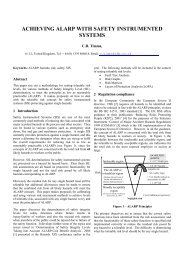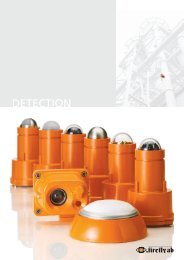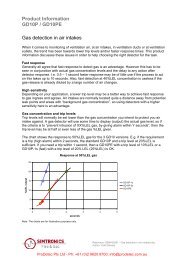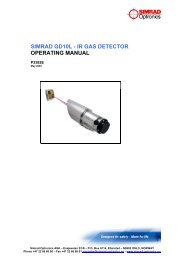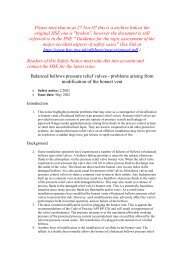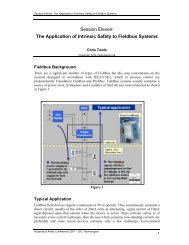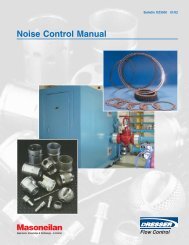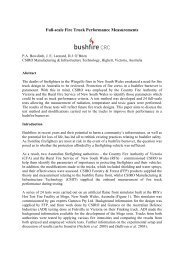The Striking Role of Partial Valve Stroke Testing to meet ... - ICEWeb
The Striking Role of Partial Valve Stroke Testing to meet ... - ICEWeb
The Striking Role of Partial Valve Stroke Testing to meet ... - ICEWeb
- No tags were found...
Create successful ePaper yourself
Turn your PDF publications into a flip-book with our unique Google optimized e-Paper software.
Safety-PLC's striking role for <strong>Partial</strong> <strong>Valve</strong> <strong>Stroke</strong> <strong>Testing</strong>Bert KnegteringHoneywell Safety Management SystemsP.O. Box 1165201 AC 's-Her<strong>to</strong>genbosch<strong>The</strong> Netherlandsbert.knegtering@honeywell.comKey wordsSafety-PLC, Safety Integrity, IEC 61508, <strong>Partial</strong> <strong>Valve</strong> <strong>Stroke</strong> <strong>Testing</strong>Abstract<strong>Partial</strong> <strong>Valve</strong> <strong>Stroke</strong> <strong>Testing</strong> or PVST, is an emerging concept <strong>to</strong> au<strong>to</strong>matically increase the performance<strong>of</strong> Safety Instrumented Systems. PVST is a concept where safety-related valves like ESD valves andshut-<strong>of</strong>f valves are au<strong>to</strong>matically tested concerning failure modes that are related <strong>to</strong> valve sticking andslowing down operation. Current trends in the industry show an upcoming number <strong>of</strong> dedicatedtechnical PVST solutions by various au<strong>to</strong>mation and instrumentation vendors.<strong>The</strong> added value <strong>of</strong> PVST within the process industries is a significant reduction <strong>of</strong> the frequency <strong>of</strong>required manual periodic valve pro<strong>of</strong> tests, its related manual test cost and reduced spurious trips due <strong>to</strong>manual errors. <strong>Partial</strong> testing is performed by additional au<strong>to</strong>mated test instrumentation, which caneasily be initiated and controlled by the safety-instrumented systems’ logic solver such as the safetyrelatedPLC.This paper will discuss practical examples <strong>of</strong> <strong>Partial</strong> <strong>Valve</strong> <strong>Stroke</strong> <strong>Testing</strong> in which it appears that SIL 1rated valves can be upgraded <strong>to</strong> SIL 2, and <strong>of</strong>f-line pro<strong>of</strong> test intervals which can be extended from 2 <strong>to</strong>5 years.1 IntroductionTrends in the market place show an increasing demand for partial valve stroke testing techniques. At thesame time, more and more vendors <strong>of</strong> process instrumentation <strong>of</strong>fer technical solutions that have theability <strong>to</strong> realize a certain level <strong>of</strong> partial valve stroke testing. <strong>The</strong> underlying cause for this trend ispartly due <strong>to</strong> the growing insight that cost can be saved by au<strong>to</strong>mated on-line partial valve stroke testingand partly by new safety standards that push the industry <strong>to</strong> implement a minimum level <strong>of</strong> au<strong>to</strong>matedon-line fault diagnostic coverage. Safety PLC-based systems appear <strong>to</strong> play an important central roleconcerning the initiating, registration an responding <strong>to</strong> PVST, whereas other solutions may use nonsafetyrelated equipment.Copyright 2004 by ISA – <strong>The</strong> Instrumentation, 1 Systems and Au<strong>to</strong>mation Society.Presented at ISA 2004 Hous<strong>to</strong>n Technical Conference; www.isa.org
2 What is PVST?A substantial amount <strong>of</strong> safety valves that are applied in process installation are only used in case <strong>of</strong> anout-<strong>of</strong>-control process. <strong>The</strong> frequency by which these dedicated safety valves are activated during itsentire lifetime <strong>of</strong> many years, is in most situations restricted <strong>to</strong> only once or a few times. Some safetyvalves will never need <strong>to</strong> come <strong>to</strong> action. Because <strong>of</strong> the importance <strong>of</strong> reliable operation <strong>of</strong> thesevalves in case <strong>of</strong> such an out-<strong>of</strong>-control process, periodic tests will reveal possible failures. Due <strong>to</strong> thevery rare moments that the valve is operated, one <strong>of</strong> the most likely failure modes that may occur issticking <strong>of</strong> the valve. Physical influences may lead <strong>to</strong> erosion, corrosion or pollution, which obstruct thevalve <strong>to</strong> move and correctly close or open. During periodic <strong>of</strong>f-line pro<strong>of</strong> tests, these failure modes canbe revealed, but due <strong>to</strong> the fact that such <strong>of</strong>f-line tests can most times only be done during a completeunit or plant shut-down, such tests normally only take place once per year or even once per couple <strong>of</strong>years.One can imagine the impact <strong>of</strong> valve sticking in combination with the low-test frequency on the reliableoperation <strong>of</strong> the valve. At the moment the valve does not function anymore, the failure will reside in thevalve until the next <strong>of</strong>f-line test. <strong>The</strong> longer the time span until this next test, the higher the probabilitywill be that due <strong>to</strong> an out-<strong>of</strong>-control process, a demand is done on this valve.As a result <strong>of</strong> this, the reliability performance (i.e. the likelihood <strong>of</strong> the availability <strong>of</strong> its functionality)<strong>of</strong> the valve globally depends on two aspects. First <strong>of</strong> all, the mean time <strong>to</strong> failure due <strong>to</strong> corrosion andpollution, and secondly the time it takes <strong>to</strong> detect and resolve this failure.<strong>Partial</strong> <strong>Valve</strong> <strong>Stroke</strong> <strong>Testing</strong> (PVST) is a concept that is characterized by partly on-line valve testing.This partly testing concerns the test <strong>of</strong> the valve whether it is sticking at its defined normal position orwhether it is not sticking and still able <strong>to</strong> move. PVST implies the partially opening or closing <strong>of</strong> thevalve, e.g. 10% <strong>of</strong> a full stroke, detection with sensors like position switches that the valve has reachedthis 10% movement and moving the valve back <strong>to</strong> its normal position. If this test is done within arelatively short predefined time frame, it will in many applications not lead <strong>to</strong> a disturbance <strong>of</strong> theprocess and can therefore be done on-line.Figure 1 shows a typical example <strong>of</strong> a basic PVST solution which can be found in ISA-TR84.0.002[ISA84b]. This PITT (<strong>Partial</strong> Instrument Trip Test) solution uses a second solenoid <strong>to</strong> create acontrolled leakage <strong>of</strong> the valve and uses the normal trip solenoid for emergency situations. Obviously, itmust be noted that for this solution the valve including the actua<strong>to</strong>r is tested but not the normal tripsolenoid. This is a typical situation that illustrates the importance <strong>of</strong> a thorough and dedicated FailureMode and Effect Analysis (FMEA) <strong>of</strong> the initial valve including the additionally needed PVSTequipment.Copyright 2004 by ISA – <strong>The</strong> Instrumentation, 2 Systems and Au<strong>to</strong>mation Society.Presented at ISA 2004 Hous<strong>to</strong>n Technical Conference; www.isa.org
PITT (TEST)SOVPLC BASEDEMERGENCYSHUTDOWNSYSTEMLeakage testSOVMManuallyoperated SOVLimit switch100% closedLSLSLimit switch10% openTRIP (ESD)SOVInstrumentAir SupplySHUT OFF VALVE (FC)3 Market expectations and needsFigure 1 Example <strong>of</strong> a PVST solutionIn July 2003 a survey was conducted among 16 operating companies in the process industries, whichwere stationed in the Netherlands and Belgium. Based on this cus<strong>to</strong>mer survey, the following generalconclusions were drawn:♦ More or less all operating companies in the process industries are familiar with the PVSTconcepts.♦ <strong>The</strong> general opinion is that PVST adds value <strong>to</strong> their business.♦ To date, not many companies have already applied the PVST concept.♦ Different companies have different ideas on the added value and potential negative aspects <strong>of</strong>PVST.Al <strong>to</strong>gether, it was concluded that there is a serious market for PVST solutions, which can only be sweptif the added value can be proven.4 Detectable failuresFailures related <strong>to</strong> 100% operation i.e. fully closing or fully opening are not covered by PVST, becausetesting against such failure modes normally results in an undesired process upset or shutdown. As inmost cases the most dominant failure mode appears <strong>to</strong> be sticking <strong>of</strong> a valve at its normal position,PVST is considered <strong>to</strong> contribute significantly <strong>to</strong> the detection <strong>of</strong> this type <strong>of</strong> failures and resolve themin a relatively short time period. <strong>The</strong> reliability <strong>of</strong> the valve will therefore significantly increase. Thiswill be explained in the next section. Typically, PVST might help <strong>to</strong> deduce the failure modes that arerelated <strong>to</strong>:• <strong>Valve</strong> sticking• Packing problemsCopyright 2004 by ISA – <strong>The</strong> Instrumentation, 3 Systems and Au<strong>to</strong>mation Society.Presented at ISA 2004 Hous<strong>to</strong>n Technical Conference; www.isa.org
• Leakage (pneumatic)• Actua<strong>to</strong>r spring rate deviation• Delayed operation<strong>The</strong> ability <strong>to</strong> au<strong>to</strong>matically and on-line detect instrument failure by additional test instrumentation, isnormally expressed in terms <strong>of</strong> Diagnostic Coverage or DC. <strong>The</strong> higher the fraction <strong>of</strong> failures that isau<strong>to</strong>matically detected, the higher the DC. This DC is a parameter that is <strong>of</strong>ten expressed in apercentage or the coverage fac<strong>to</strong>r. Obviously, this DC level depends on the PVST technique that is usedand it depends on the application for which the valve is used. Figure 2 shows an example <strong>of</strong> the failuremode categories <strong>of</strong> a safety valve that is normally open and normally energized. In case <strong>of</strong> an out <strong>of</strong>control process, the valve needs <strong>to</strong> close. <strong>The</strong> design specifications such as normally open or normallyclosed, normally energized or normally de-energized, determine the consequence per failure mode i.e.resulting in a safe state or in a potentially dangerous failure <strong>to</strong> function. <strong>The</strong>se design specificationscombined with the likelihood <strong>of</strong> the occurrence <strong>of</strong> these failure modes will subsequently determine theDC level.UndetectedSAFEClosesspontaneouslydue <strong>to</strong> loss<strong>of</strong> energyDANGEROUSStuck a<strong>to</strong>penDetectedUndetectedDetectedBy voltagecontrolBy valvestroke testFigure 2 Failure modes <strong>of</strong> a safety valve<strong>The</strong>refore, concerning the establishment <strong>of</strong> the actual achieved level <strong>of</strong> DC a FMEA should beconducted. Aspects like the design <strong>of</strong> the valve, the design <strong>of</strong> the PVST equipment, the application <strong>of</strong>the valve, the environmental circumstances, etc. should all be taken in<strong>to</strong> account.5 <strong>The</strong>oretical analysis <strong>of</strong> the impact <strong>of</strong> PVST on the PFD performanceBased on a number <strong>of</strong> valve related reliability influencing parameters the Probability <strong>of</strong> Failure onDemand (PFD) value can be calculated. Equations for the PFD calculation are for instance given bysafety standards like IEC 61508 (part 6 annex B).In case no tests are done and no repairs are made, one can imagine that the PFD <strong>of</strong> the valve willincrease over time. <strong>The</strong>refore, a distinction needs <strong>to</strong> be made between the momentary PFD or PFD(t)and the average PFD with regard <strong>to</strong> a predefined time period, such as the <strong>of</strong>f-line pro<strong>of</strong> test interval.<strong>The</strong> following set <strong>of</strong> equations illustrates the relationship between the PFD <strong>of</strong> the valve and the mostrelevant reliability influencing parameters. <strong>The</strong>se parameters are:— λ Dangerous : <strong>The</strong> rate or frequency <strong>of</strong> dangerous failures <strong>of</strong> the valve— DC : Diagnostic Coverage— TI : <strong>The</strong> <strong>of</strong>f-line pro<strong>of</strong> Test IntervalCopyright 2004 by ISA – <strong>The</strong> Instrumentation, 4 Systems and Au<strong>to</strong>mation Society.Presented at ISA 2004 Hous<strong>to</strong>n Technical Conference; www.isa.org
— MTTR : Mean Time To RepairPFD( t)= (1 − DC) *λ0 TIMTTRDangeroust→ 0→λ * + DC *Dangerous* t(Equation 1)PFDt=TIAverage[0→ TI ]= t=0PFD(t)dtTI(Equation 2)With the assumption that MTTR
such that a higher Safety Integrity Level (SIL) can be claimed. This is a major advantage that can beachieved by PVST and might prevent the need <strong>of</strong> additional valves that would be required <strong>to</strong> realize theneeded PFD Average by implementing fault-<strong>to</strong>lerance.Obviously, it must be noted that also the other SIS-subsystems need <strong>to</strong> be considered when it come <strong>to</strong>calculation <strong>of</strong> the PFD Average <strong>of</strong> the complete safety instrumented function.<strong>The</strong> graphical plot illustrated in Figure 4 zooms in<strong>to</strong> part <strong>of</strong> Figure 3 for the parameter values TI for 1 <strong>to</strong>5 years and for DC fac<strong>to</strong>rs 0%, 30% and 60%.1,00E-03PFD average1,00E-020%30%60%1,00E-011 2 3 4 5Off-line pro<strong>of</strong> TI [years]Figure 4 PFD Average related <strong>to</strong> TI for 1 <strong>to</strong> 5 years and for DC fac<strong>to</strong>rs 0%, 30% and 60%Figure 4 clearly shows the critical boundary between PFD Average values that are higher than 1,00E-2 andvalues that are smaller than 1,00E-2. According <strong>to</strong> safety standards like IEC 61508 the 1,00E-2represents the boundary between SIL 1 and SIL 2. <strong>The</strong> importance <strong>of</strong> PVST is clearly illustrated inFigure 5. This figure shows that if;— DC = 0% the maximum acceptable TI = 2 years— DC = 30% the maximum acceptable TI = 3 years— DC = 60% the maximum acceptable TI = 5 yearsCopyright 2004 by ISA – <strong>The</strong> Instrumentation, 6 Systems and Au<strong>to</strong>mation Society.Presented at ISA 2004 Hous<strong>to</strong>n Technical Conference; www.isa.org
1,00E-030%PFD averageSIL 21,00E-02SIL 1DC = 0%Max TI =2 yearsDC = 30%Max TI =3 years30%60%DC =60%Max TI =5 years1,00E-011 2 3 4 5Off-line pro<strong>of</strong> TI [years]Figure 5 Illustration <strong>of</strong> the impact <strong>of</strong> DC on the maximum TI for SIL 2Based on the calculation, whereas due <strong>to</strong> PVST the DC is increased from 0% up <strong>to</strong> 60%, it is concludedthat a significant gain is achieved by an extended maximum acceptable <strong>of</strong>f-line pro<strong>of</strong> test interval from 2years up <strong>to</strong> 5 years.7 Architectural constraintsSIS standards like IEC 61508 and IEC 61511 have defined restrictions on the use <strong>of</strong> a SIS subsystem ordevice for particular SIL’s. <strong>The</strong>se constraints are based on the fault-<strong>to</strong>lerance, the novelty <strong>of</strong> the deviceand the so-called Safe Failure Fraction or SFF. This SFF represents a combination <strong>of</strong> the fraction <strong>of</strong>failures that result in a safe state and the fraction <strong>of</strong> failures that are au<strong>to</strong>matically detected.Typically, using PVST, a DC level <strong>of</strong> 60-90% is achieved. This DC, combined with the fraction <strong>of</strong>failures which result in a safe state, result in a SFF <strong>of</strong> above 60% or sometimes even above 90%. <strong>The</strong>practical example as given in the ARC white paper [ARC01], where the hazard rate is reduced from1500 years in<strong>to</strong> 13,000 years, implies a DC level <strong>of</strong> 88,5%. This would most likely result in an achievedSFF <strong>of</strong> above 90%. Concerning the architectural constraints, the subject valve would therefore not berestricted <strong>to</strong> be used up <strong>to</strong> and including SIL 3.8 Current technical solutionsInvestigation <strong>of</strong> the current market place <strong>of</strong> PVST solutions and products has resulted in the observation<strong>of</strong> about a dozen different types <strong>of</strong> technical solutions or products as <strong>of</strong>fered by the variousinstrumentation vendors. <strong>The</strong>se solutions are typically characterized by features such as the application<strong>of</strong> limit switches, valve positioners, jammers, etc. Most <strong>of</strong> these techniques <strong>of</strong>fer their test results ingraphical formats, <strong>of</strong>ten named valve signature, valve footprint, valve fingerprint, etc.Copyright 2004 by ISA – <strong>The</strong> Instrumentation, 7 Systems and Au<strong>to</strong>mation Society.Presented at ISA 2004 Hous<strong>to</strong>n Technical Conference; www.isa.org
Depending on the typical application and the most dominant failure modes that should be covered byPVST, an available technical solution can be selected. Criteria, such as the inclusion <strong>of</strong> the solenoid, theactua<strong>to</strong>r, valve leakage internally and externally, travel time requirements and so on, will result in theselection <strong>of</strong> one <strong>of</strong> those techniques. Measurement based on air pressure, valve stem position,temperature, will determine whether this technique is adequate.It must subsequently be noted that no single currently available PVST product is <strong>to</strong> be considered asbeing the best choice for any process related practical situation. For each practical problem where PVSTis considered <strong>to</strong> add value the best technique will need <strong>to</strong> be investigated.9 <strong>The</strong> central role <strong>of</strong> the PLCDespite the fact that many <strong>of</strong> the currently available techniques are <strong>of</strong>fered as being fully stand-aloneproducts, practical implementation examples <strong>of</strong> these products, show that an important role is attributed<strong>to</strong> the safety PLC. This safety PLC <strong>of</strong>ten fulfils the so-called logic solver function as being part <strong>of</strong> thecomplete SIF where also the valve is part <strong>of</strong> as being the actua<strong>to</strong>r.Obviously, PVST solutions that are characterized by the application <strong>of</strong> limit switches and the operation<strong>of</strong> dedicated PVST test-solenoids, the safety PLC forms the intelligent ‘hart’. In addition <strong>to</strong> this, otheravailable ‘stand alone’ PVST products <strong>of</strong>ten make use <strong>of</strong> the safety PLC for actions such as alarmManagement, Periodic PVST initiation, MTTR timer control, safe process shut-down or trip actions, andSOE registration.<strong>Striking</strong>ly, it is observed that the safety PLC, which is mostly already in place for process safeguardingpurposes, can <strong>of</strong>ten be used in an expanded way and combine its primary functions with the tasks <strong>to</strong>perform or support PVST. A key advantage <strong>of</strong> using the safety PLC for PVST is that it is alreadydesigned according SIS-related standard like IEC 61508. Some Safety PLC systems suppliers havealready included PVST as a standardized solution in<strong>to</strong> their product portfolio.Concerning a PVST project that was executed already in the mid 90’s by the company the author isemployee <strong>of</strong>, the cus<strong>to</strong>mer had a clear desire concerning the Mean Time To Repair (MTTR) timercontrol requirements. ‘As far as MTTR timing is concerned, the first question is whether it is neededand this depends upon the SIL, the degree <strong>of</strong> fault <strong>to</strong>lerance and the improvement in SFF being claimedas a result <strong>of</strong> the PVST. In some cases it was needed, in others it was not. <strong>The</strong> next difficult question iswhat do you do when the MTTR timer elapses? For an input, you trip the input on which the fault hasoccurred and the MTTR timer has elapsed. <strong>The</strong>re is not a lot <strong>of</strong> point in doing this for an output whichis know <strong>to</strong> have failed since it won't work anyway. In this case you have <strong>to</strong> trip other process partswhich will remove the hazard by other means such that failure <strong>of</strong> the valve will not cause a hazard. Thiscan be very difficult <strong>to</strong> achieve.’ Obviously, such a difficult task needs <strong>to</strong> be analyzed up front and therequired au<strong>to</strong>matic protective action needs <strong>to</strong> be performed by the safety-related PLC.Using the safety-related PLC for PVST also significantly increases the amount <strong>of</strong> information obtainedfrom valve testing. With the increase in equipment status data gathered by safety-related PLC it ispossible <strong>to</strong> compare the performance and condition <strong>of</strong> each safety valve against the performance <strong>of</strong> thevalve when it was new or newly maintained. This also significantly increases the diagnostic coverage <strong>of</strong>the safety valve test while, at the same time, the information as handled by the PLC can be used forpredicting the maintenance needs <strong>of</strong> particular valves.Copyright 2004 by ISA – <strong>The</strong> Instrumentation, 8 Systems and Au<strong>to</strong>mation Society.Presented at ISA 2004 Hous<strong>to</strong>n Technical Conference; www.isa.org
Despite the fact dedicated PVST supporting field equipment is currently available in the market place, itis concluded that the safety-related PLC plays a central and significant role when it comes <strong>to</strong> theimplementation <strong>of</strong> PVST and gaining its full benefits. This is based on the following aspects:• Control <strong>of</strong> the MTTR timer requirements• Compliance with safety standards like IEC 61508 and IEC 61511• Periodic initiation <strong>of</strong> PVST actions• Data logging, reporting and management• Universal ability <strong>of</strong> work with any PVST supporting field device• Huge installed base which can be expanded for PVST application• Controlled initiation <strong>of</strong> required alternative trip actions10 Conclusion<strong>The</strong> benefits PVST is that it might <strong>meet</strong> governmental-, insurance- and safety standards safetyrequirements for critical ESD valve loops. Furthermore PVST will reduce the full stroke test interval(process downtime) for given safety level. It enlarges acceptable <strong>of</strong>f-line pro<strong>of</strong> test interval resulting in;— Less cost <strong>of</strong> out-<strong>of</strong>-service <strong>of</strong> the valve— Less cost <strong>of</strong> testing— Less probability <strong>of</strong> human errors due <strong>to</strong> manual testing— Compliance with a higher SIL, thus no doubled cost due <strong>to</strong> no longer need for duplicated valves— Reporting compliant with safety standards IEC 61508 and IEC 61511— Less probability <strong>of</strong> people being victim <strong>of</strong> a hazardous event, if their presence in the hazardous areadue <strong>to</strong> test activities is reduced.As stated by the ARC Advisory Group back in September 2001 [ARC01]:‘Not only is the manual work associated with conventional testing methods expensive, but alsounreliable. <strong>The</strong>re are a number <strong>of</strong> deficiencies in conventional testing methods, which raise theuncertainty over whether safety valves will actually be available in case <strong>of</strong> an emergency. Concernover the reliability <strong>of</strong> conventional safety valve testing procedures is due <strong>to</strong> a number <strong>of</strong> reasonsincluding the lack <strong>of</strong> real-time data and the absence <strong>of</strong> trending data. Another significant drawback<strong>to</strong> conventional testing methods is that they render the valve unavailable during testing if a realsafety issue is encountered. Conventional valve testing procedures also put the burden on BPtechnicians <strong>to</strong> manually return safety valves <strong>to</strong> their proper operating mode after completing thetests. If an emergency were <strong>to</strong> occur during the testing procedure, or if a safety valve were <strong>to</strong> be leftwith its range <strong>of</strong> motion restricted, the valve would be unavailable <strong>to</strong> prevent a fire or explosionduring a process upset. As a result <strong>of</strong> these risks, and its highly labor-intensive nature, BP feels itmust improve its safety valve testing procedures.’It is concluded that PVST adds a significant contribution <strong>to</strong> the valve reliability. Higher SIL’s can beachieved, less maintenance costs are made, and less manual tests are required.<strong>The</strong> safety PLC appears <strong>to</strong> fulfill a significant role when is comes <strong>to</strong> the implementation <strong>of</strong> many PVSTsolutions which are currently available in the market place. <strong>The</strong> massive installed base <strong>of</strong> safety PLCCopyright 2004 by ISA – <strong>The</strong> Instrumentation, 9 Systems and Au<strong>to</strong>mation Society.Presented at ISA 2004 Hous<strong>to</strong>n Technical Conference; www.isa.org
<strong>of</strong>fer an excellent platform for PVST expansion. Compliance with safety-related standards issubsequently easily achieved.11 References[IEC61508][IEC61511][ISA96][ISA98][ARC01]IEC 61508 – Functional safety <strong>of</strong> electrical/electronic/programmableelectronic safety-related systems 1998/2000IEC 61511 – Functional safety: Safety-instrumented Systems for the processindustry sec<strong>to</strong>r (Draft version 1999)ANSI/ISA S84.01 – 67 Alexander Drive, P.O. Box 12277, Research TrianglePark, NC 27709 1996ISA TR84.00.02 Part 4 – 67 Alexander Drive, P.O. Box 12277, ResearchTriangle Park, NC 27709 1998ARC Advisory Group– Neles ValvGuard Allows BP <strong>to</strong> Increase Safety WhileReducing CostsARC White Paper September 2001Copyright 2004 by ISA – <strong>The</strong> Instrumentation, 10 Systems and Au<strong>to</strong>mation Society.Presented at ISA 2004 Hous<strong>to</strong>n Technical Conference; www.isa.org




